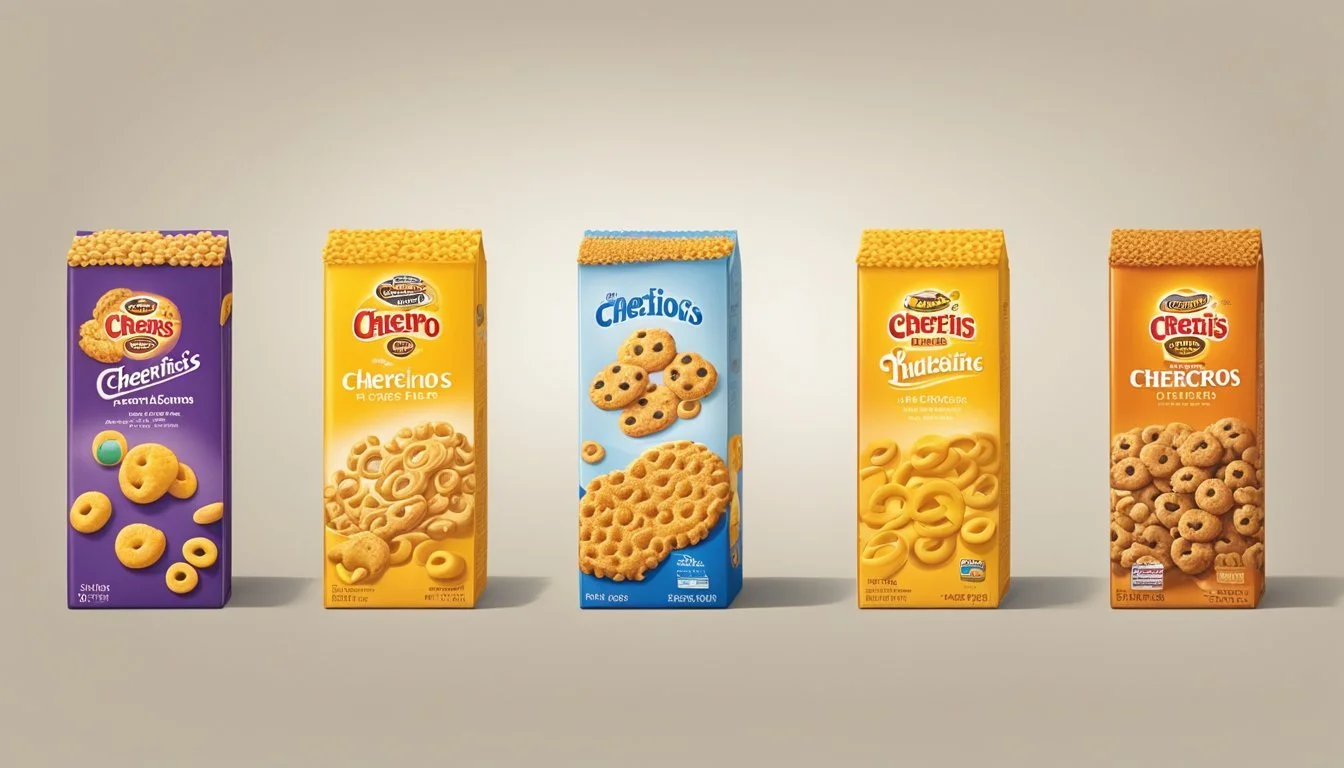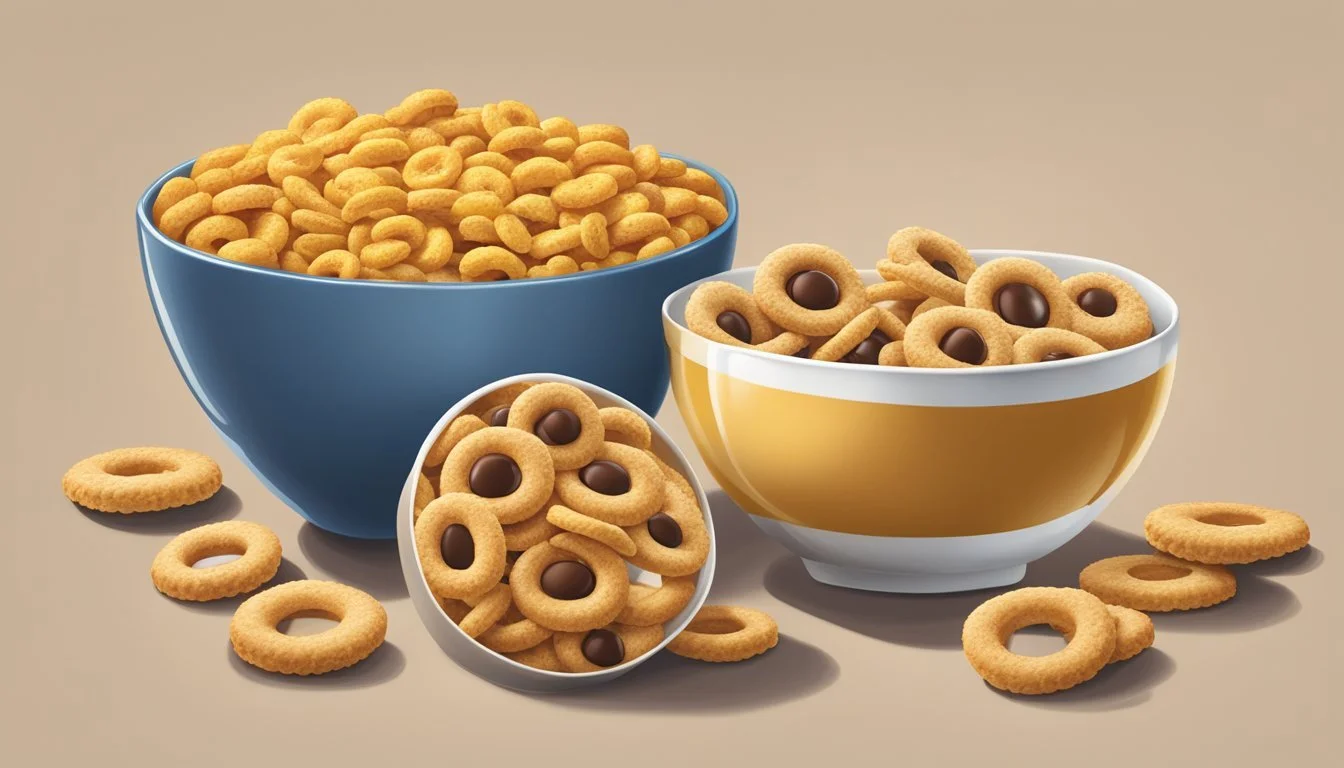Cheerios vs Cookie Crisp
Comparing Nutritional Value and Taste
This Article is Part of Our Breakfast Cereal Guide with Details on Cheerios Nutrition and Cookie Crisp Nutrition
When it comes to breakfast cereals, the debate between Cheerios and Cookie Crisp often highlights the balance between health and indulgence. Cheerios, known for their heart-healthy benefits, provide significant nutritional value with high iron and manganese content. Meanwhile, Cookie Crisp offers a sweeter start to the day, packed with higher vitamin B2 levels, which can be enticing for those with a sweet tooth.
However, it's essential to examine what you're looking for in your breakfast choice. For individuals focused on a healthy breakfast, Cheerios are a better option due to their lower sugar content and additional nutrients vital for daily functions. Cookie Crisp, while enjoyable, tends to be higher in sugar and carbs, making it more suitable as an occasional treat rather than a daily staple.
Both cereals have their unique appeal. Parents might prefer Cheerios for their children due to the health benefits, whereas kids might lean towards the fun and flavorful taste of Cookie Crisp. Understanding the nutritional differences can help make a more informed choice tailored to your dietary needs and preferences.
Historical Development and Brand Overview
Cheerios was first sold on May 1, 1941, under the name CheeriOats. This cereal was developed by General Mills and later rebranded to Cheerios in 1945 due to a trademark dispute. The name change simplified the branding and enhanced market appeal.
Cookie Crisp entered the market in 1977. Cookie Crisp was initially produced by Ralston Purina and featured small pieces that resembled chocolate chip cookies. General Mills took over the trademark in 1997.
The science behind Cheerios involved creating a machine to puff oat dough into small, torus-shaped pieces. In contrast, Cookie Crisp focused on mimicking the taste and appearance of chocolate chip cookies for the breakfast table.
Mascots and Marketing:
Cheerios has often been marketed for its health benefits and simple ingredients.
Cookie Crisp has had several mascots over the years, including Cookie Jarvis and Cookie Crook, adding a playful and whimsical element to its branding.
Geographical Influence:
General Mills manufactures both cereals in the United States.
In other countries, Cereal Partners produces Cheerios and Cookie Crisp.
This developmental timeline and branding strategy reflect both cereals' diverse appeal and their evolution in the breakfast cereal market.
Nutritional Profiles
When comparing Cheerios and Cookie Crisp, significant differences in their nutritional profiles become apparent. This analysis will highlight variations in macro-nutrients, vitamins, minerals, sugar, and fat content.
Macro-nutrients and Calories
Cheerios and Cookie Crisp have distinct macronutrient profiles. Cheerios offer a more balanced mix of macronutrients. A typical serving of Cheerios contains roughly 100 calories, providing 3 grams of protein, 1 gram of fat, and 20 grams of carbohydrates.
Cookie Crisp, on the other hand, is more calorie-dense with about 120 calories per serving. It has 2 grams of protein, 2 grams of fat, and 25 grams of carbohydrates. Cookie Crisp tends to have higher carbohydrate content, but both cereals offer limited protein and fat.
Vitamins and Minerals Content
Cheerios are fortified with a diverse range of vitamins and minerals. They deliver significant amounts of Iron (198% of daily needs), Vitamin B12, Vitamin B6, and Folate.
Cheerios also provide notable amounts of Manganese, Phosphorus, Zinc, and Selenium. In contrast, Cookie Crisp contains higher levels of Vitamin B2. Both cereals include essential vitamins such as Vitamin A RAE but tend to vary widely in their mineral content.
Sugar and Fat Comparative Analysis
Cheerios are lower in sugar content compared to Cookie Crisp. A serving of Cheerios contains about 1 gram of sugar, making it a lower-sugar option. Cookie Crisp, however, contains around 12 grams of sugar, which is considerably higher.
Regarding fat content, both cereals are relatively low in fat but Cookie Crisp has slighty more fat content. Cheerios have 1 gram of fat per serving, while Cookie Crisp comes in with 2 grams of fat. The higher sugar content in Cookie Crisp contributes significantly to its overall caloric count.
Taste and Texture Experience
Cheerios and Cookie Crisp offer distinct sensory experiences that appeal to different taste preferences and breakfast habits. Both cereals cater to diverse consumer tastes but with unique texture profiles.
Consumer Taste Preferences
Cheerios, known for their mild, slightly oaty flavor, are often appreciated for their simplicity and versatility. Consumers frequently enhance the taste by adding toppings like fresh fruits or a sprinkle of sugar. These additions bring out a sweeter, more complex flavor profile while maintaining the cereal's nutritious image.
Cookie Crisp, in contrast, is celebrated for its sweet, chocolatey flavor, mimicking the taste of chocolate chip cookies. It appeals to those with a sweet tooth wanting a dessert-like experience for breakfast. The cereal's rich flavor tends to stand alone without the need for additional toppings, making it an instant favorite for children and dessert cereal lovers.
Texture Analysis
Cheerios have a light, crunchy texture when dry, which softens quickly when soaked in milk. This rapid transition from crunchy to soft offers a dynamic eating experience. Some consumers might enjoy the initial crunch, while others appreciate the softened texture that follows. The texture variability lends Cheerios to a variety of eating styles, from quick snacking to leisurely breakfast eating.
Cookie Crisp maintains a crisp, firm texture even after prolonged exposure to milk. This resilience keeps the cereal crunchy, contributing to its cookie-like appeal. The consistent texture aligns with its bold flavor, offering a satisfying crunch that complements the sweet taste. This makes it suitable for those who prefer a consistent, crunchy texture throughout their breakfast experience.
Health Impact
Cheerios and Cookie Crisp offer distinct nutritional profiles which impact their health benefits and dietary considerations differently. It's important to consider content like vitamins, minerals, sugars, and fats for each cereal.
Health Benefits and Concerns
Cheerios are known for being low in saturated fat and providing essential nutrients. They are rich in Iron, covering 198% more of the daily Iron needs compared to Cookie Crisp. They also provide significant amounts of Vitamin A RAE, Vitamin B12, and Folate.
Cookie Crisp, while higher in Vitamin B2, contains more sugars and less fiber. The higher sugar content can be a concern for those monitoring their intake. Additionally, Cheerios have a better profile for maintaining good heart health due to the presence of whole grains and lower sugar content.
Dietary Considerations
When choosing between Cheerios and Cookie Crisp for a healthy breakfast, consider the nutritional goals. Cheerios have added benefits of higher Iron, Manganese, and Folate levels. They also contain Phosphorus and Vitamin B6, essential for various body functions.
On the other hand, those needing Vitamin B2 might lean towards Cookie Crisp, but they should be aware of its higher sugar and sodium content. For families looking for healthier choices, Cheerios offer a more balanced nutrient profile without excessive calories or unhealthy ingredients. This makes them a more suitable choice for both children and adults aiming to sustain energy throughout the day.
Economic Considerations
When comparing Cheerios and Cookie Crisp, it's essential to evaluate the economic aspects, such as cost and overall value for money. These factors can significantly impact consumers' choices.
Cost Analysis
The price of Cheerios tends to be lower than Cookie Crisp. In many supermarkets, a standard 12-ounce box of Cheerios can cost around $3.50, whereas Cookie Crisp usually sells for approximately $4.00 for the same size. This cost difference may seem minor but adds up over time, especially for families who regularly purchase cereal in bulk.
Moreover, frequent promotions and discounts on Cheerios can make it even more affordable. In contrast, Cookie Crisp is less often found on sale, making Cheerios the cheaper and more budget-friendly option for many shoppers.
Value for Money
Cheerios provides more nutritional benefits relative to its cost compared to Cookie Crisp. Cheerios offer a higher content of essential nutrients such as Iron, Folate, and Vitamins B12 and B6. This enhances its value proposition, as consumers receive more nutritional bang for their buck.
Cookie Crisp has higher Vitamin B2 content but falls short in other nutritional areas. For households focused on nutrient density, Cheerios offers better value. Given its lower cost and richer nutrient profile, Cheerios is a more economical choice without compromising on quality or nutrition.
Conclusion
When comparing Cheerios and Cookie Crisp, several key factors emerge.
Nutritional Content
Cheerios are a powerhouse for essential nutrients. They offer significant amounts of Iron, Manganese, Folate, Vitamin A, and other vital vitamins and minerals. Cookie Crisp, while high in Vitamin B2, falls short in other nutritional areas.
Nutrient Cheerios Cookie Crisp Iron Higher Lower Vitamin B2 Lower Higher Manganese Higher Lower
Sugar and Calories
Cheerios contain less sugar and are generally considered a healthier option for sustained energy. Cookie Crisp has a higher sugar content, making it a more indulgent choice.
Cheerios:
Lower in sugar
Balanced nutritional profile
Cookie Crisp:
Higher in sugar
More of a treat cereal
Taste and Appeal
Taste preferences can vary. Cheerios' mild flavor appeals to those looking for a simple, healthy start to their day. Cookie Crisp offers a sweet, dessert-like taste, which may be more appealing to children and those with a sweet tooth.
Final Thoughts
Cheerios are more nutrient-dense and ideal for those focusing on health and nutrition. Cookie Crisp serves as a treat or an occasional indulgence. Both cereals have their place, depending on what one prioritizes in their breakfast choice.






